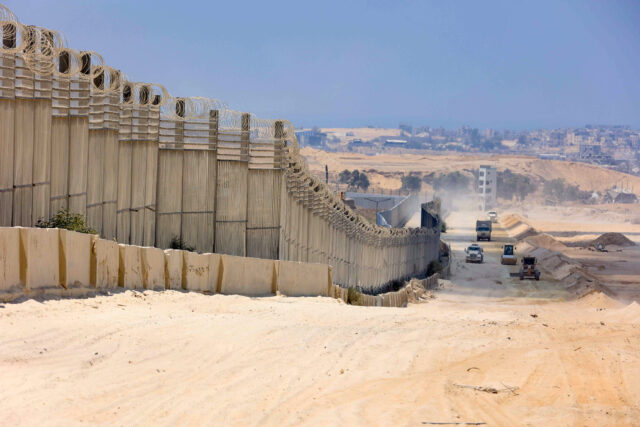The city of Rafah in Gaza is only half of the city of Rafah. Therein lies the story of Egypt and terror tunnels — why Israel needs to retain a presence on the Egypt/Gaza border and the Philadelphi corridor, and why the US should support Israel and Egypt in securing the border together.
A skinny, L-shaped strip of land along the Mediterranean was supposed to be part of an Arab country created alongside Israel in 1948. But that state never came to fruition, because the Palestinian Arabs and five Arab countries decided to launch a war of extermination against Israel. They lost, and only the State of Israel was born.
By the 1949 Armistice, that L-shape had become a rectangle along the Mediterranean, occupied by Egypt, and used as a duty-free port for the Egyptian military. It was a wreck.
In 1967, when the Arab countries again tried to destroy Israel and lost, the Jewish State took control of the Gaza Strip along with the entire Sinai Desert.
Between 1968 and 1985, infant mortality was reduced from 90 per 1,000 live births to 35. Life expectancy went from 53.4 years to 66.4 years. Gaza went from fewer than 800 teachers (thanks, UNRWA) to more than 20,000. Similar increases took place in water availability, farm production, industry, telecommunications, and school construction and attendance. The population increased accordingly, from about 475,000 in 1968 to more than 525,000 in 1985.
The trends were precisely the same in Judea and Samaria, only with a larger size sample. The trajectory was up; straight up.
Until it wasn’t.
In the negotiations for the Camp David Accords, Egypt insisted that Israel keep the Gaza Strip, and in 1982, when Israel left Sinai, a Gaza-Sinai border was reestablished. The city of Rafah had grown to straddle the line, so Israel suggested moving the border to either side of the city — Egypt refused, and Rafah was divided. But it wasn’t really. Smuggling tunnels already connected the two sides.
With the Oslo Accords, a Palestinian Authority (PA) force was put on the border alongside Israel. When Israel pulled out of Gaza entirely in 2005, a new Egypt-Israel agreement, the Philadelphi Accord, was based on the principles of the 1979 peace treaty. Border control was turned over to Egypt, while the supply of arms to the PA was subject to Israeli consent.
The agreement specified that 750 Egyptian guards would be deployed along the length of the border, and Egypt and Israel pledged to work together to stem terrorism, arms smuggling, and other illegal cross-border activities. A separate agreement between Israel and the PA was signed. The European Union Border Assistance Mission at the Rafah Crossing Point (EU BAM Rafah) was created, and the European Union Police Mission (EUPOL COPPS) signed on in 2005 as well.
In 2007, all of those agreements took a dive, making reliance on the written word tenuous, at best.
Hamas took control of Gaza in a brief and bloody civil war. The late-and-mostly-unlamented Ismail Haniyeh proposed a joint Hamas, Egypt, European border group, but the Europeans left and Egypt closed the border — except for the smuggling part, which was part civilian smuggling and part Hamas/Muslim Brotherhood-financed-by-Iran smuggling.
A fascinating report entitled Look for another homeland: Forced evictions in Egypt’s Rafah, and housed at the Library of Congress, tells the story. Egypt’s President Hosni Mubarak was ousted in 2013, partly as a result of US pressure, leaving a security vacuum. Either that year or in 2014, Egypt began demolishing homes and evicting the Rafah population on the Egyptian side.
According to the book:
Egypt justified the evictions as a way to defeat the insurgents by shutting down smuggling tunnels from Gaza, through which, they alleged, the insurgents received weapons and fighters.
The Egyptian military forcibly evicted about 3,200 families, destroying as many buildings in the process, as well as hundreds of hectares of farmland. Families told Human Rights Watch the army warned them of the eviction only 48 hours or less in advance. The government’s compensation has been inadequate, and the authorities gave evicted families no effective way to challenge their eviction or their compensation. The government provided no temporary housing. Since then, the government has provided little proof that the tunnels support the insurgency and has not explained why it could not have destroyed the tunnels using less destructive means. Human Rights Watch found that Egypt’s actions violated international human rights law (IHRL) that protect civilians against forced evictions. [emphasis added]
In the latter part of that decade, Israel worked with Egypt to defeat a combination of Bedouin tribes and ISIS in northern Sinai, with some intelligence assistance by the US, but a very low profile by the US-led Multinational Force in the Sinai. In January 2023, Egypt declared an end to the insurgency — although that isn’t really clear.
Now, Israel is back in Gaza and if the IDF finishes its mission and controls the Philadelphi Corridor, Hamas will not be able to regroup, re-arm, or reconstitute itself.
Egypt clearly sees the threat to its stability and future. It seems to have trouble accepting that Israel is part of the solution. There is a role here for the United States — if it would stop “negotiating” with Hamas, the enemy of its friends, and bring Israel and Egypt together to do the job both need to have done.






